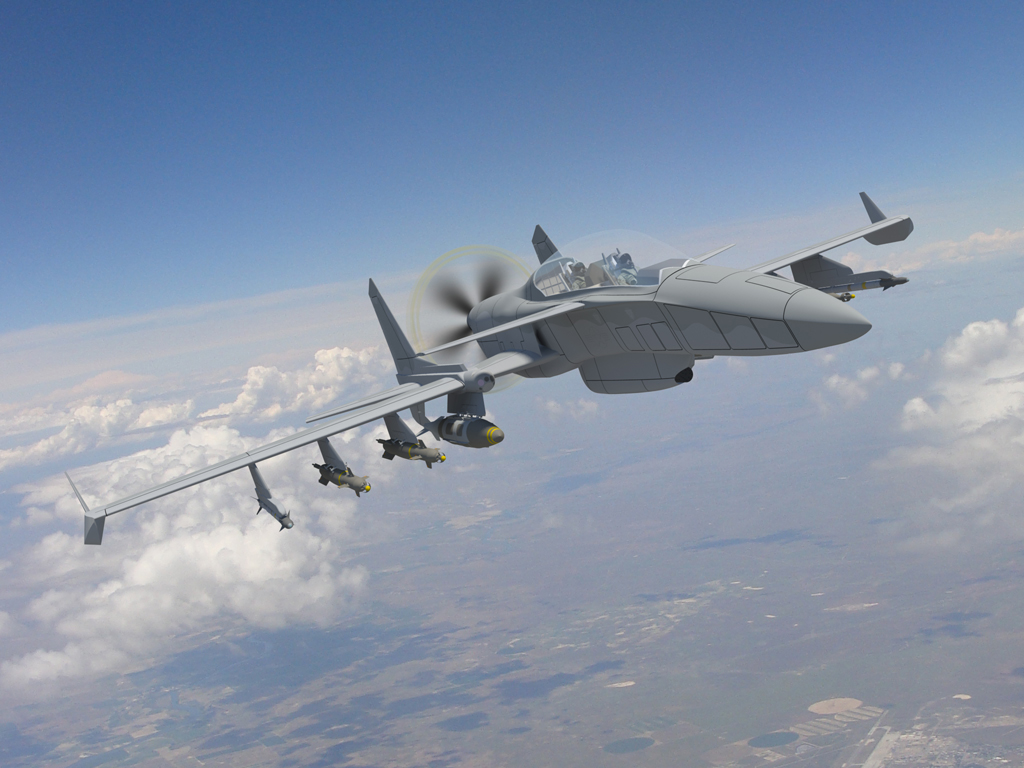Release of New Machete Series Configuration
On March 2nd Stavatti released the new the configuration for the Machete family of next generation, single engine Close Air Support (CAS)...
Release of New Machete Series Configuration
On Monday, March 2nd, Stavatti Aerospace released the new the configuration for the Machete family of next generation, single engine Light Attack, Lightweight Fighter and Advanced Trainer aircraft. The New Machete configuration was “Frozen” on Friday, February 27th. Marking the completion of a 15-month design improvement effort, the Machete program is now entering the detail design phase. In January 2008 Stavatti initiated a design improvement effort to significantly enhance overall Machete performance, capabilities and interoperability per recommendations of current warfighters and potential systems-users alike. Tailored to address the specific needs of international customers while ensuring intelligent integration into domestic force structure, the new Machete configuration is optimized to excel at tomorrow’s CAS mission.
Building upon the baseline Machete configuration of 2007, the SM-27 Turboprop and Turbofan variants experienced a dramatic improvement in range, endurance and warload. Wingspan of the SM-27 models increased from 43 ft to 50 ft, resulting in 62 sq ft of additional wing area and two additional external stores hardpoints. The SM-27 fuselage length was lengthened by approximately five ft, with overall aircraft height increasing by nine inches. Maximum internal fuel of the SM-27S/T was increased from 2,600 lbs to 5,000 lbs while the internal fuel capacity of the SM-27J/L rose to 6,000 lbs. External warload of the SM- 27S/T increased from 5,000 to 6,500 lbs. SM-27J/L warload with maximum internal fuel likewise increased to 8,500 lbs. Retaining the proven PW127G powerplant, the propeller diameter of the SM-27S/T turboprop was increased to 120 in.
To improve performance at all altitudes while assuring a uniform supportability across the turbofan Machete line, the original SM-27J/L PW308C powerplant was replaced by a single non- afterburning derivative of the GEAE F414-GE-400. Resulting in an aircraft with extraordinary short field and transonic cruise performance, maximum level speed of the SM-27J/L was increased to over Mach 0.87 while tactical radius on internal fuel increased to 735 nm. To broaden mission capability, the ventral mounted centerline 30mm GAU-13/A cannon was made standard across the SM-27 line, with provisions for 675 rds of ammunition in single seat and 470 rds in two seat tandem variants. All domestic and NATO export variants of the SM-27 series will benefit from a comprehensive EW suite that includes the AN/ALQ-211(V)4 AIDEWS, the AN/ALQ-165 ASPJ and up to 14 AN/ALE-47 countermeasures dispensers.
Derived from the SM-27J/L the SM-47S/T Super Machete was dramatically improved to compete head-to- head with the JAS-39C Gripen in the Air Defense Fighter role while satisfying future Advanced Pilot Training/T-38C successor requirements. Powered by a single GEAE F414-GE-400 or F414 EDE, the SM-47S/T internal fuel load has been increased to 7,250 lbs corresponding to a mission radius of 760 nm. With an external warload of 11,000 lbs and a maximum level speed in excess of Mach 1.8, the SM-47S/T will be an extremely capable light-weight fighter. SM-47S/T wingspan was increased from 28 ft to 36 ft, with gross wing area growing by 130 sq ft. Total external hardpoints were increased from six to eight, while a nose-mounted 20mm M61A2 Vulcan cannon with 1,000 rds becoming the standard fixed internal armament for the SM-47S. Standard avionics include the AN/APG-67(V4) multi-mode radar with ASPIS serving as the base-line self-protection suite. All variants of the Machete family have seen notable improvements including the addition of standard probe-and-drogue in-flight refueling probes, an increase in avionics and sensors growth volume and the selection of new, fully integrated self-protection systems.
Most apparent, however, is a rethinking of the Machete cockpit to include reclined ejection seats, Block 60 F-16 style flight and throttle grips and an all- glass cockpit featuring five 6 x 8 in L3 displays for the forward crewstation and six 6 x 8 in L-3 displays in the aft cockpit of two seat models. Designed to benefit from HMDs or HUDs per customer requirements, the new Machete cockpit may also feature the L3 Large Area Avionics Display (LAAD) to ensure JSF similarity in the APT role. Engineered with modularity in-mind, single and two seat cockpit modules are inter- changeable between same variant type aircraft for enhanced cost savings and mission-readiness. Machete series detail design is now underway. Stavatti anticipates prototype construction of the SM- 27S/T/J/L to begin in the first quarter of 2010 with prototype assembly of the SM-47S/T scheduled to begin in 2011.
The Machete series, including the SM-27S/T Turboprop, SM-27J/L Turbofan and SM-47S/T Super Machete, is a family of modular COunter-INsurgency (COIN), Close Air Support (CAS), Forward Air Control (FAC), Advanced Trainer (AT), Lightweight Fighter (LWF), Lead-In Fighter (LIF), Air Defense Fighter (ADF), Dissimilar Air Combat Training (DACT) and Advanced Pilot Training (APT) aircraft. Developed as a privately sponsored, corporate initiative to satisfy anticipated COIN/CAS and LWF/APT needs, the Machete will provide efficient, highly survivable warfighter air support.

